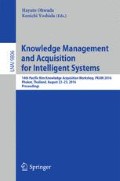Abstract
Although there is an abundance of how-to guides online, systematically utilising the collective knowledge represented in such guides has been limited. This is primarily due to how-to guides (effectively, informal process descriptions) being expressed in natural language, which complicates the process of extracting actions and data. This paper describes the use of Ripple-Down Rules (RDR) over the Stanford NLP toolkit to improve the extraction of actions and data from process descriptions in text documents. Using RDR, we can incrementally and rapidly build rules to refine the performance of the underlying extraction system. Although RDR has been widely applied, it has not so far been used with NLP phrase structure representations. We show, through implementation and evaluation, how the use of action-data extraction rules and knowledge acquisition in RDR is both feasible and effective.
Access this chapter
Tax calculation will be finalised at checkout
Purchases are for personal use only
Notes
- 1.
In this paper, we use the terms process and workflow interchangeably.
- 2.
www.ehow.com, eHow.
- 3.
www.wikihow.com , WikiHow.
- 4.
Recipes are also useful for subsequent studies in personal process analysis, but that is beyond the scope of this paper.
- 5.
For the complete set of part-of-speech tags generated by the Standford parser, see http://www.comp.leeds.ac.uk/amalgam/tagsets/upenn.html.
- 6.
However, adding a new operator is a straightforward task in our system.
- 7.
WordNet 3.0, https://wordnet.princeton.edu.
References
Compton, P., Jansen, R.F.: A philosophical basis for knowledge acquisition. Knowl. Acquisition 2(3), 241–258 (1990)
Dani, M., Faruquie, T., Garg, R., Kothari, G., et al.: A knowledge acquisition method for improving data quality in services engagements. In: Services Computing, pp. 346–353. IEEE (2010)
Hajimirsadeghi, S.A., Paik, H.-Y., Shepherd, J.: Social-network-based personal processes. In: Bae, J., Suriadi, S., Wen, L. (eds.) AP-BPM 2015. LNBIP, vol. 219, pp. 155–169. Springer, Heidelberg (2015)
Ho, V., Wobcke, W., Compton, P.: EMMA: an e-mail management assistant. In: Intelligent Agent Technology, pp. 67–74. IEEE (2003)
Hsu, J.O., Paik, H., Zhan, L.: Similarity search over personal process description graph. In: Wang, J., Cellary, W., Wang, D., et al. (eds.) WISE 2015, Part I. LNCS, vol. 9418, pp. 522–538. Springer, Heidelberg (2015). doi:10.1007/978-3-319-26190-4_35
Kim, M.H., Compton, P.: Improving the performance of a named entity recognition system with knowledge acquisition. In: ten Teije, A., Völker, J., Handschuh, S., Stuckenschmidt, H., d’Acquin, M., Nikolov, A., Aussenac-Gilles, N., Hernandez, N. (eds.) EKAW 2012. LNCS, vol. 7603, pp. 97–113. Springer, Heidelberg (2012)
Kim, M.H., Compton, P., Kim, Y.S.: RDR-based open IE for the web document. In: K-CAP, pp. 105–112. ACM (2011)
Kim, Y.S., Park, S.S., Deards, E., Kang, B.H.: Adaptive web document classification with MCRDR. In: ITCC, vol. 1, pp. 476–480 (2004)
Kwok, R.B.H.: Translations of ripple down rules into logic formalisms. In: Dieng, R., Corby, O. (eds.) EKAW 2000. LNCS (LNAI), vol. 1937, pp. 366–379. Springer, Heidelberg (2000)
Manning, C.D., Surdeanu, M., Bauer, J., Finkel, J., Bethard, S.J., McClosky, D.: The stanford CoreNLP natural language processing toolkit. In: ACL (Systems Demonstration), pp. 55–60 (2014)
Nguyen, D.Q., Pham, S.B., Pham, D.D.: Ripple down rules for part-of-speech tagging. In: Gelbukh, A.F. (ed.) CICLing 2011, Part I. LNCS, vol. 6608, pp. 190–201. Springer, Heidelberg (2011)
Richards, D.: Two decades of ripple down rules research. Knowl. Eng. Rev. 24(2), 159–184 (2009)
Wobcke, W., Krzywicki, A., Chan, Y.-W.: A large-scale evaluation of an e-mail management assistant. In: Web Intelligence and Intelligent Agent Technology, pp. 438–442. IEEE (2008)
Xu, J., Paik, H., Ngu, A.H.H., Zhan, L.: Personal process description graph for describing and querying personal processes. In: Sharaf, M.A., Cheema, M.A., Qi, J. (eds.) ADC 2015. LNCS, vol. 9093, pp. 91–103. Springer, Heidelberg (2015)
Author information
Authors and Affiliations
Corresponding author
Editor information
Editors and Affiliations
Rights and permissions
Copyright information
© 2016 Springer International Publishing Switzerland
About this paper
Cite this paper
Zhou, D., Paik, HY., Ryu, S.H., Shepherd, J., Compton, P. (2016). Building a Process Description Repository with Knowledge Acquisition. In: Ohwada, H., Yoshida, K. (eds) Knowledge Management and Acquisition for Intelligent Systems . PKAW 2016. Lecture Notes in Computer Science(), vol 9806. Springer, Cham. https://doi.org/10.1007/978-3-319-42706-5_7
Download citation
DOI: https://doi.org/10.1007/978-3-319-42706-5_7
Published:
Publisher Name: Springer, Cham
Print ISBN: 978-3-319-42705-8
Online ISBN: 978-3-319-42706-5
eBook Packages: Computer ScienceComputer Science (R0)

